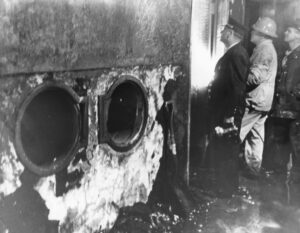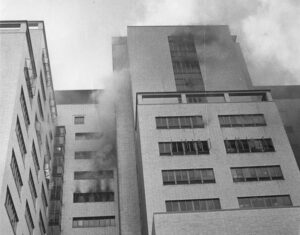08 Dec On This Day In History: Massive Changes to Healthcare Safety Laws Resulted from the Hartford Hospital Inferno in 1961
Although unfathomable in the safety-conscious world we live in today, a cigarette was carelessly tossed down a trash chute inside a Connecticut hospital, causing a tragic blaze. The 1961 inferno that killed 16 people, including seven patients, five visitors, two staff members, a nurse, and a doctor, also led to sweeping changes to fire and life safety codes that reshaped hospitals throughout the United States.
Although it’s beyond comprehension to think of smoking in a hospital today, in the 1960s, it was not so uncommon. The offending cigarette was disposed of in Hartford Hospital’s 9th-floor trash chute. The chute linking the hospital’s 13 floors didn’t lead directly to an incinerator. Instead, the waste accumulated in sizable bins in the basement until the hospital’s janitorial team removed it.
When passing the first-floor trash chute on that December day, hospital janitor Arthur LaFontaine saw smoke. He worked quickly to extinguish the flames using a fire hose and believed it was contained. Not long later, nurse Sonia Sandner observed smoke emerging from the ninth-floor chute door and hurried to shut the fire doors. At 2:39 p.m., one hour after LaFontaine first noticed the smoke, a nurse on the twelfth floor activated the fire alarm.
Soon after, an explosion from the trash chute erupted on the hospital’s ninth floor, propelling the chute door to fly across the opposite side of the corridor. Flames leaped from the open chute, devouring everything highly flammable in its path—linoleum wainscoting, wallpaper, and cane-fiber ceiling tiles in the hallway.
Hospital personnel quickly began an evacuation, establishing a line, transferring patients from one individual to the next, and directing them toward the stairwell—some still in their beds and wheelchairs. Those who opted not to leave, including employees, patients, and visitors, sealed themselves in patient rooms. They blocked gaps under doors with damp linens to prevent asphyxiation. For those who stayed, survival depended on their ability to accomplish this before shifting pressure forced the rolling door latches to push open.
The Hartford Fire Department (HFD) arrived quickly, only to find that their 100-foot ladder did not quite reach the ninth floor. “Firefighter Richard Trejarian raced up the ladder in full turnout gear. At the top, Trejarian leaped to an open ninth-floor window. With his feet swinging free, he pulled himself through the window and dropped to the floor,” reported Lisa Nadile in the February 2009 edition of NFPA Journal. “Surrounded by thick black smoke from burning ceiling tile, linoleum, plastics, wood, and other combustibles, Trejarian moved fast, assessing the situation, closing doors, and shouting instructions to people on the floor. “He said, ‘Run the water. . . wet towels and rags, line them around the doors,'” recalls firefighter Frank Droney, 81, a retired 32-year HFD veteran.
Trejarian’s fellow HFD firefighters broke windows and carried 2-½” fire hoses up the hospital’s stairs. They also used standpipes and internal fire hoses that were present on all floors in the hospital. They weren’t the only heroes. In a rescue effort, Dr. Norman Hedenstad entered the ninth floor, passing charred bodies as he searched for survivors. In the end, he lost his life, along with 15 others whose ages ranged from 14 to 87.
HFD firefighters were able to contain the fire quickly, managing to extinguish it by 4 p.m. Some smoke had migrated onto other floors above, and evacuations were required, but there was no loss of life beyond the ninth floor.
In the wake of the ferocious fire, an investigation ensued. Findings led to voluntary standards and laws that sparked change in healthcare occupancy safety nationwide. “As a result of the Hartford Hospital fire (coupled with similar incidents in healthcare facilities), over the course of several code cycles, many fire and life safety code provisions were enacted nationwide affording additional protection to the fragile populations in these facilities,” said Rob Sontag, CFPS, a senior fire protection consultant with TERPconsulting, a national fire protection engineering firm.
Because the hospital was made of brick, automatic sprinklers weren’t required before the blaze. “The fire at Hartford Hospital emphasized the importance of automatic fire sprinkler systems in controlling and suppressing fires. This led to the widespread adoption of sprinkler systems as a standard feature in building codes, especially in high-risk structures like hospitals,” explained Rob, who has extensive experience surveying health facilities to ensure compliance with federal and state fire codes and life safety regulations.
Other changes to hospital fire and life safety provisions included restricting vertical openings (such as laundry chutes) design parameters, limiting the length of dead-end corridors, banning roller latches on patient room doors, reducing the utilization of fire escapes and replacing them with fire-separated exit stairs, and mandating the utilization of flame-retardant building materials. Many of these changes entered the National Fire Protection Association’s (NFPA) 101, — Life Safety Code in 1963, including sprinklers in trash chutes, fire barriers, and fire-resistant draperies.
“The incident also underscored the need for well-defined emergency preparedness and evacuation plans in healthcare facilities,” said Rob, who formerly served as a committee member of the NFPA 99 Technical Correlating Committee and the NFPA 99 – Fundamentals of Health Care Facilities Committee. “Subsequent regulations emphasized the importance of conducting regular fire drills, training staff on evacuation procedures, and ensuring that emergency exits are clearly marked and accessible.”
In 2011, to commemorate the 50th anniversary of the fire, Hartford HealthCare produced a documentary, “The Hartford Hospital Fire: Inferno on the 9th Floor,” which includes hospital employee accounts and film shot inside the hospital as the fire raged. Outlining one of the worst hospital fires in American history, it can be viewed at The Hartford Hospital Fire: Inferno on the 9th Floor – YouTube.
“The Hartford Hospital fire has had a lasting impact on fire safety practices and regulations, particularly in healthcare facilities,” concluded Rob. “The lessons learned from this tragic event contributed to improvements in building design, fire prevention measures, and emergency response protocols, making these buildings safer for the fragile occupants they serve.”
Photos courtesy of the Hamilton Archives at Hartford Hospital.





No Comments